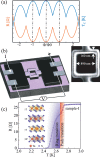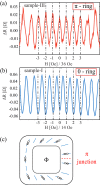The observation of π-shifts in the Little-Parks effect in 4Hb-TaS2
- PMID: 38816364
- PMCID: PMC11139670
- DOI: 10.1038/s41467-024-48260-x
The observation of π-shifts in the Little-Parks effect in 4Hb-TaS2
Abstract
Finding evidence of non-trivial pairing states is one of the greatest experimental challenges in the field of unconventional superconductivity. Such evidence requires phase-sensitive probes susceptible to the internal structure of the order parameter. We report the measurement of the Little-Parks effect in the unconventional superconductor candidate 4Hb-TaS2. In half of our rings, which are fabricated from single-crystals, we find a π-shift in the transition-temperature oscillations. According to theory, such a π-shift is only possible if the order parameter is non-s-wave. In the absence of crystallographic defects, the shift provides evidence of a multi-component order parameter. Thus, this observation increases the likelihood of the two-component order parameter scenario in 4Hb-TaS2. Furthermore, we show that Tc is enhanced as a function of the out-of-plane field when a constant in-plane field is applied, which we explain using a two-component order-parameter.
© 2024. The Author(s).
Conflict of interest statement
The authors declare no competing interests.
Figures




References
-
- Alicea J, Fendley P. Topological phases with parafermions: theory and blueprints. Annu. Rev. Condens. Matter Phys. 2016;7:119–139. doi: 10.1146/annurev-conmatphys-031115-011336. - DOI
Grants and funding
LinkOut - more resources
Full Text Sources
Research Materials
Miscellaneous

